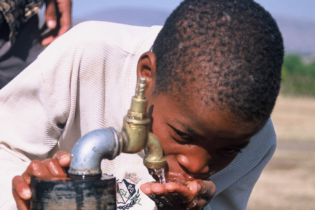A solicited research project, initiated and funded by the Water Research Commission (WRC) and led by Dr Nicola Rodda of the University of KwaZulu-Natal, clarifies the benefits as well as the risks associated with the use of greywater.
The potential contribution of household and urban food gardens to food security is limited by a shortage of water,which can be used to supplement rainfall. Greywater may help to overcome this limitation by providing a dependable source of water that is under the control of the household gardener. Although more than half of indoor household water use can normally be intercepted as greywater, potential users are uncertain about the risks and local authorities are also uncertain as to what their approach should be. Active promotion of greywater use for irrigation in gardens and small-scale agriculture has the potential, not only to maximise use of limited water supplies, but also to improve food security in low-income settlements. However, before this practice can be promoted through government structures and local authorities, the legal status of greywater use for irrigation needs to be clarified and guidance needs to be formulated for users so that small-scale irrigation use of greywater is performed in a way that is safe for humans, plants and the environment. Two products were generated by the WRC study in an effort to help guide the wise use of greywater: a user-friendlyguide and a supporting technical background document capturing the scientific information on which the guide is based. It is envisaged that the outcomes of this project will provide municipalities, NGOs and householders with greater certainty about how to minimise the health risks and optimise the benefits associated with the use of greywater, specifically in peri-urban or urban food gardens. What is greywater? According to Dr Rodda, greywater can be defined as the untreated household effluent from baths, showers, kitchen and hand-wash basins, as well as laundry (i.e. all non-toilet uses). More than half of indoor household water use is normally undertaken for these purposes – estimates range from 50% to 80%. This percentage represents a large fraction of household wastewater which can potentially be intercepted by the householder and used for additional beneficial uses. However, the amount of greywater generated per household varies greatly. The variation is affected by factors such as dynamics of the family, water usage patterns, age distribution of occupants and lifestyle characteristics. Greywater generated in low-income, unsewered areas can be as low as 20 to 30 litres per person per day, whereas it can be about 90 to 120 litres per person per day in houses with sewage systems. In general, in areas with sewage, greywater represents about 65% of the total wastewater stream, whereas, in areas without sewage, the production of greywater could reach 100%. Concerns about the use of greywater The WRC study highlights concerns about human health, which could be threatened in the process of using greywater for food production. This is due to the fact that greywater contains micro-organisms from skin surfaces and dirt, from small amounts of urine and faeces (e.g. from washing of soiled nappies or bedclothes), and from the washing and preparation of food. Standing greywater also provides an environment in which micro-organisms can survive and proliferate. As a result, greywater usually contains significant numbers of micro-organisms, some of which may be capable of causing disease in those who come in contact with it, or with plants and crops irrigated with this type of water.In addition to containing substances which are beneficial to plants (mainly nitrogen and phosphorus), greywater also contains substances that can reduce plant growth or crop yield if present at sufficiently high concentrations, such as salts, sodium and boron. Extreme pH can also be damaging to plants.
Some constituents of greywater can change soil properties so that it becomes progressively less productive (i.e. less able to support plant growth). Because soil properties change slowly, these tend to be long-term effects, while effects on plant growth and yield are more short-term. The major concerns with regard to soil are salinity and sodicity, both of which are related to the increased concentration of sodium in greywater. Other greywater constituents which may affect soil adversely are oil and grease, and suspended solids.Many of these concerns can be overcome by adequate management of greywater irrigation in terms of measures taken to reduce risks and control the quality and quantity of greywater used. The biggest problem lies with informal shack settlements with no sewage systems in South Africa, where there are limited waterborne services and drainage. In these areas, greywater often merges with toilet water and other effluent flows, thus creating a toxic mix of contaminated water that poses a danger to human health and the environment. Although the per capita volume of greywater disposed of on the ground in the vicinity of shack dwellings is low, greywater runoff often carries solid and liquid waste contaminants that collect in ponds and are frequently discharged via stormwater systems into wetlands and rivers. Dr Gerhard Backeberg, director for Water Utilisation in Agricultureat the WRC says, “Current legislation pertaining to disposal and use of water and waste falls short in that a definition of greywater as a separate wastewater stream is lacking. Clarity is needed for the future by explicit definition of greywater and the beneficial uses to which it may be put. The existing legislation does not specifically exclude use of greywater for irrigation, but there are inconsistencies which arise from the absence of a clear definition of greywater as a subset of domestic wastewater which differs in character and hazards from blackwater (wastewater including toilet waste). These need to be resolved to clarify the legal position of use of greywater for irrigation.” Conclusion The project produced a Guidance Report to assist potential greywater users in identifying measures to reduce therisks highlighted above.The following were listedamongst many recommendations made by the study: Potential greywater users need to be involved in planned greywater implementations from the planning stages, informing them of the benefits and risks of greywater use for irrigation, allowing them to express their views and concerns and providing a mechanism for them to be involved in decision-making.Potential irrigation users of greywater also need information in order to practise greywater irrigation in a safe and sustainable manner. Once greywater implementation has been planned and initiated, greywater users need on-going monitoring and support. This should be tailored to meet the different information and support needs of low-income rural and peri-urban settlements, as well as middle- to higher-income urban settlements.References
• Guidance report (WRC Report No. TT469/10) entitled Sustainable Use of Greywater in Small-Scale Agriculture and Gardens in South Africa
• Technical report (WRC Report No.1639/1/10 (with the same title)







